- Submissions

Full Text
Progress in Petrochemical Science
Mechanism of Particle Migration and Damage of Permian Igneous Rocks Reservoir in Sichuan Basin
Jie S1, Weian H1,2*, Weihua C3, Xiaojie L4, Rong Z3, Dandan Z3 and Rui W1
1School of Petroleum Engineering, China University of Petroleum (East China)
2China Key Laboratory of Unconventional Oil & Gas Development, China University of Petroleum (East China), China
3Engineering Technology Research Institute of Petrochina Southwest Oil and Gas Field Company, China
4Drilling Fluid Branch of Western Drilling Engineering Company, China
*Corresponding author: Weian H, China Key Laboratory of Unconventional Oil & Gas Development, China University of Petroleum (East China), China
Submission: January 27, 2021;Published: February 16, 2021

ISSN 2637-8035Volume4 Issue1
Abstract
There is little research on the damage mechanism of igneous rocks reservoir in the domestic and overseas. It is of great significance to clarify the potential damage factors of particle migration of igneous rock, and to illustrate the damage degree and damage mechanism of this kind of special reservoir. The experimental results of microstructural observations and mineral analysis of natural and outcrop igneous rocks in laboratory studies showed that the mineral composition and microstructure of natural and outcrop igneous rocks were similar, and microscale or nanoscale dissolution fractures are mainly developed. However, the physical properties of outcrop cores are slightly worse than those of natural cores, the average porosity of natural cores and outcrop cores were about 20% and 2.79%, respectively. In the experimental results of nuclear magnetic resonance on-line monitoring, the start-up gas flow rate of natural core was 4mL/min. With the increasing of floe rate, the proportion of micro-pores in natural cores decreased and the proportion of macro-pores increased, the changes of mesoporous were not obvious. The results of core flow plugging experiment showed that the large particles could not all enter the core throat and would form plugging at the core edge, while most of the nanoscale particles can enter the core leading to the permeability damage of 68.5%. Through the CT scanning experiments, it was found that the proportion of pore space in the middle of the core was reduced by 56.1% when the nanoscale particles were driven into the core, the particle plugging was obvious. Hence, there are immense exploration prospects of the damage mechanisms for igneous rocks reservoir in the process of particle migration.
Keywords:Igneous rock; Particle migration; Damage mechanism; Nuclear magnetic resonance; CT scanning
Introduction
The migration of reservoir particles is one of the important factors causing reservoir
damage. When the particles migrate to the narrow pore throat at a certain flow rate, they
can be piled up to block the seepage channel, thus causing reservoir damage and reducing
the productivity of oil and gas wells [1]. At present, the domestic and foreign research on
sandstone reservoirs generally consider that the formation particles are some tiny mineral
components cemented on the skeleton particles or loosely attached to the pore network. Under
the dynamic action, they release, migrate and block the pore throat, resulting in the decrease
of permeability; or the external fluid and the original formation water are not compatible, they
will react each other to form precipitation, the precipitated particles are carried by the fluid
to the small pore channel to form a bridge plug [2,3]. The main clay minerals in the reservoir
are kaolinite, montmorillonite, illite and chlorite. Kaolinite can be released into the fluid and
migrate because of its small volume and no expansibility; montmorillonite is an expansive
clay, which can expand when meeting fresh water, resulting in the decrease of porosity and
permeability, and it can also be released from the surface of pores and migrate; illite can
form a variety of crystal structures, and sometimes grow and expand in pores with irregular
fibrous structure; chlorite is strongly acid sensitive and precipitates with iron compounds
after acid treatment. Non clay mineral particles mainly include quartz, feldspar, mica, calcite and other carbonate and silicate particles. In view of the fact that
kaolinite is distributed as a single particle on the surface of sand
particles, while illite is distributed in pores in a network, the two
minerals (especially the former) were first assumed to be the
main components of formation particles. However, after analyzing
the composition of particles in the core discharge during particle
migration, it is found that the particle composition is mainly
quartz and other non-clay minerals, and basically does not contain
clay minerals. Therefore, it is considered that formation particles
are not limited to clay minerals. Balle and Happe thinks that it is
a conjecture based on microscopic observation that the particle
damage is attributed to clay minerals, and there is no reliable
experimental basis. However, according to the possibility that
there are no or few clay minerals in the effluents, it is difficult
to completely discharge the clay minerals due to the migration
damage, because this may just indicate that the clay minerals are
captured by the throat and are not easy to be discharged. Muecke’s
definition of the upper limit of formation particle size (37μm) with
the minimum mesh size (200 mesh) seems to be too high, because
the average throat of conventional sandstone is only a few microns,
and the average throat of tight sandstone is less than 1μm [4-6].
In order to study whether there is particle migration in
reservoir, we should start from two aspects. First of all, we
should judge whether there are loose or falling particles from the
internal characteristics of the reservoir. Second, we should use
the experimental method to judge whether the particles in the
reservoir will migrate and under what conditions under which they
can migrate, so as to confirm whether there are potential damage
factors that may cause particle migration in the reservoir, only in
this way can the measures to prevent the damage caused by particle
migration be more clearly guided. The core flow experiment [7,8] is
the most commonly used and intuitionistic experimental method to
judge particle migration in reservoir. Velocity sensitive and forward
and reverse flow experiments can be used to directly judge particle
migration in reservoir. Velocity sensitivity test is a basic method to
judge particle migration in reservoir core, but it is not reliable to use
velocity sensitivity test alone. It needs to analyze and judge with the
aid of forward and reverse flow experiment and reservoir related
geological data, the transport of particles [9-13] can be judged.
Through the microscopic detection and analysis of geological data
such as mineral composition and cementation state of reservoir
rocks, the occurrence of core particle migration can be predicted
or verified [14]. The research on particle migration at home and
abroad is mainly focused on sandstone reservoir, and there are few
reports on particle migration in igneous rock. Therefore, based
on the study of mineral composition and microstructure type
of igneous rock core, this paper evaluates the damage degree of
particle migration of igneous rock through particle migration startup
velocity test, forward and reverse core flow test, combined with
rock sample nuclear magnetic resonance on-line detection [15-17].
Furthermore, the types of particle migration and the corresponding
damage mechanism are clarified, and the measures to prevent
particle migration in igneous rocks are more clearly guided [18-22].
Experiment
Materials
The natural core is taken from YT well of Permian in Sichuan Basin, and two kinds of outcrop cores are taken from Emeishan basalts. The mineral composition was analyzed using natural and outcrop rock powders of specified mesh. The microstructural analysis used cores before and after the experiment and prepared fresh sections. Cast thin sections were analyzed using natural and outcrop core sections. High purity nitrogen was used as the displacement medium for the critical velocity of particle migration. Methane gas was used as the displacement medium in NMR T2 spectroscopy. In the core flow plugging experiment, igneous particles and ultrafine calcium carbonate were used to prepare the particulate suspensions. All cores were made into standard core columns with a length of 5cm and a diameter of 2.54cm.
Instruments and methods
Mineral composition test:
A. Sample preparation: 300 mesh rock powder was prepared, and clay minerals were extracted from part of rock powder.
B. X’pert Pro MPD X-ray diffractometer was used to analyze the relative content of whole rock minerals and clay minerals.
Microstructure testing: The core before and after the experiment was selected to prepare fresh cross-section, and the microstructure was tested by in-situ scanning electron microscope, and the width, diameter, clay mineral morphology, pore filling mode and their changes were analyzed.
Critical velocity test of particle migration: To test the permeability changes of two outcrop igneous rock cores at different gas velocities, the rock samples are put into the core holder so that the flow direction of fluid in the rock sample is consistent with the gas flow direction when measuring the initial gas permeability; slowly adjust the confining pressure to 2MPa, and keep the confining pressure 1.5MPa ~ 2MPa higher than the upstream pressure of the core during the detection process, except for the stress sensitivity evaluation experiment. The high-purity nitrogen is passed through the rock sample at the initial flow rate of 1mL/min. when the pressure at the inlet and outlet of the rock sample and the flow rate at the outlet of the rock sample are stable, the pressure at the inlet and outlet of the rock sample and the gas flow rate are recorded, and the permeability and permeability damage rate are calculated; the high-purity nitrogen is passed through the rock sample at the flow rates of 1mL, 2mL, 3mL, 4mL, 5mL, 6mL, 10mL, 12mL and 20mL per minute, the permeability and permeability damage rate are calculated.
On line nuclear magnetic resonance monitoring of volcanic rock samples:
A. The core was dried at 105 ℃ to constant weight, weighed,
and measured the core size, conventional porosity and permeability
B. Methane gas was used as the displacement medium, and
1mL/min, 3mL/min, 5mL/min, 6mL/min, 10mL/min and 20mL/
min were passed through the core. The core nuclear magnetic
resonance T2 spectrum was tested to analyze the occurrence state
of fluid in core pores before and after particle migration.
Core flow plugging experiment:
A. According to the field data, it is found that the distribution
uniformity and dispersion of the sand sample are very poor, and
there are a large number of fine silt, and the fine silt accounts for
31% of the total, and most of the particles that can be transported
are less than 10μm. the particle size of the suspension with
different concentrations and different particle sizes is measured
by the better size 2000 particle size analytical instrument, and the
suspension experiment is carried out, Finally, 1 ~ 5μm volcanic
rock particle suspension and 0 ~ 1μm superfine calcium carbonate
particle suspension were prepared.
B. According to the change of permeability before and after
the injection of particles, the trapping, releasing and blocking of
particles are analyzed.
Compatibility analysis of formation grain size and core pore throat:
A. The size of formation particles was measured by the
better size 2000 particle size analytical instrument.
B. The samples of volcanic rocks are selected and tested
by apse-730 mercury injection instrument at constant rate to
obtain information such as porosity, permeability and pore size
distribution.
C. Combined with the pore size distribution results of
volcanic rock samples, the formation particle size and core pore
throat compatibility were analyzed.
CT scanning:
A. Different concentrations of formation particle suspensions
were prepared.
B. According to a certain displacement (100mg, 300mg, 600mg
particles per liter of fluid) into the core.
C. According to the change of permeability before and after the
injection of particles, the blockage of particles was analyzed.
D. Using xcf-400ct instrument, the pore structure of volcanic
rock core is scanned, all scanning parameters are recorded,
and 3D information of pore throat is obtained, and 3D image
is constructed.
E. Processing data and analyzing the influence of particle
migration on pore structure.
Results and Analysis
Mineral composition test
The mineral composition of natural rock samples in this block is mainly calcite and plagioclase, followed by quartz and clay minerals; the mineral composition of rock samples at outcrop is mainly plagioclase, followed by quartz and potassium feldspar, clay mineral content is slightly higher than that of natural core; clay minerals of outcrop and natural rock samples are mainly chlorite Tables 1 & 2.
Table 1:Analysis results of whole rock mineral composition of volcanic rock samples.

Table 2:Analysis results of relative content of clay minerals in volcanic rock samples.

Microstructure testing
The natural volcanic rock samples are cemented tightly, with fractures and pores; some of them have lamina; salt crystals; authigenic clay minerals can see intergranular chlorite and globular chlorite aggregates; the main development is micron scale dissolution particles and pores, with the size of 1.96 ~ 3.91μm. The outcrop volcanic rock samples are cemented tightly, mainly developed micron scale dissolution particles and pores, the particle surface is radial, some developed lamina, the size of dissolution pores is 1.23 ~ 6.61μm; Figures 1 & 2.
Figure 1: Scanning electron microscope of natural basal.
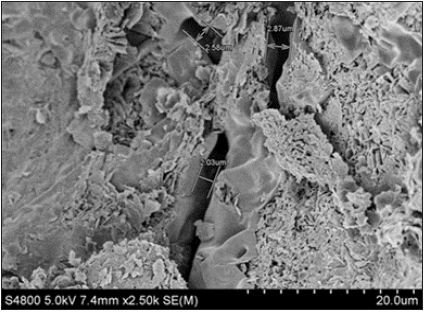
Figure 2: SEM photos of basalt samples at outcrop.
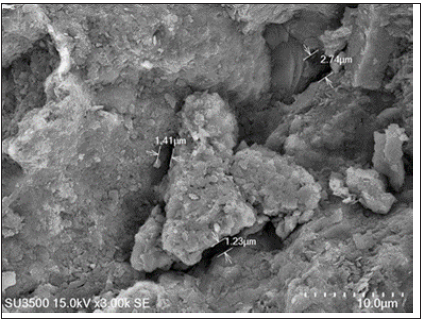
Critical velocity test of particle migration
The permeability changes of natural basalt core under different gas flow rates were tested. According to the experimental results and considering the influence of slippage effect, the curve of reciprocal average pressure and permeability was drawn, as shown in Figure 3.
Figure 3:Relationship curve between reciprocal average pressure and permeability.
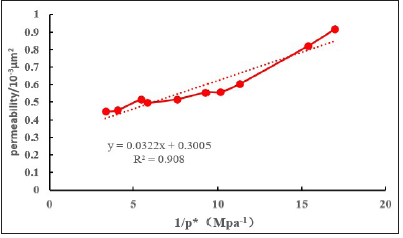
It can be seen from Figure 3 that the variation trend of core
permeability basically decreases with the increase of pressure.
With the increase of flow rate, the core permeability changes. The
permeability decreases rapidly in the initial stage, and then tends
to be stable. It shows that the gas velocity leads to the migration
of the inherent particles in the core of the reservoir, and a single
or several particles bridge to form a bridge plug at the pore throat,
causing damage to permeability. However, with the occurrence of
particle migration, the particles that can be transported gradually
decrease, and at the same time, the particles that have migrated to
the throat intercept the later particles and cause further blockage,
so the curve gradually flattens.
According to the influence factors of slippage effect, the
ratio curve between the difference between the theoretical gas
permeability and the measured gas permeability and the theoretical
gas permeability is drawn. As shown in Figure 4 the flow rate
corresponding to the point where the ratio exceeds 10% is 4mL/
min, so the critical flow rate is 4mL/min.
Figure 4:Ratio curve of velocity to theoretical and actual permeability.

In conclusion, combined with the effect of slippage effect, the maximum permeability damage rate is 10.99%, the damage degree of core at different flow rates is small, and the particle migration is not obvious.
On line nuclear magnetic resonance monitoring of volcanic rock samples
The nuclear magnetic resonance T2 curves of the experimental core under the condition of forward and reverse gas displacement of saturated methane gas are shown in Figure 5.
Figure 5:Nuclear magnetic resonance T2 spectrum curve of core particle migration in positive saturated methane gas state.

The results show that the nuclear magnetic resonance T2 spectrum of volcanic rock cores in the experiment has three peak distribution, and the relaxation time distribution range is wide, which indicates that the pore size distribution range is large and the core pore structure is complex. The strength of the left peak of the core is the highest, indicating that the proportion of small holes is high. According to the results, with the displacement flow rate increasing, the T2 spectrum curve corresponding to the time period with smaller lateral relaxation time shows a basic downward trend under a few smaller flow rates, indicating that the corresponding pore component represented by the envelope area of T2 spectrum gradually decreases in the total porosity. However, when the displacement flow rate continues to increase and reaches a certain flow rate, this change will not continue, and there is no obvious rule. The results show that, with the increase of flow rate, the proportion of micro-pores decreases, the proportion of macro-pores increases, and the proportion of meso-pores changes little. The reason is that the particles between the small holes are washed away, resulting in the decrease of the proportion of small holes. The loose particles on the surface of the core migrate and fill into the macro-pores driven by the flow rate, but the pore throat will not be blocked.
Core flow plugging experiment
Flow plugging experiments with different particle sizes and concentrations were carried out on two natural volcanic rock cores. The experimental results and evaluation data are shown in Table 3.
Table 3: Damage results of single core flow blockage experiment.

From the change of core permeability damage degree, it can be seen that different particle size or concentration of volcanic rock particle suspension has a certain degree of damage to cores with different permeability. After the core is blocked, the permeability is not easy to recover. According to the analysis of the data in table 2-8, with the increase of particle concentration, the permeability further decreases, and the permeability damage is the largest. During the experiment, with the injection of high concentration particles, the inlet pressure continues to rise, and the permeability decreases continuously, and the equilibrium cannot be reached. The consideration is that the particle size of suspension is too large, blocking the entrance end port of the core, and observing the experimental core, as shown in Figure 6.
Figure 6:Natural volcanic rock core 1-1 flow blockage after experiment.
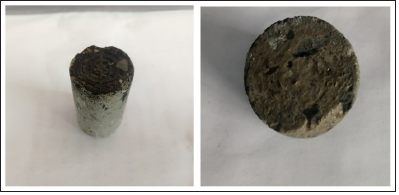
Through in-situ electron microscope scanning, the plugging of core end face pore throat was further observed. As shown in Figure 7, it can be found that before the experiment of natural volcanic rock 1-1, micro fractures on the core end face developed, and there were many holes and pores. After the experiment, it was found that the micro cracks and pores on the core surface were almost completely blocked by particles and clay, and the surface was clearly covered with flake and granular particles. Therefore, when 1~5μm volcanic particle suspension is injected, most of the particles cannot enter the pores within 3mm of the core end face, and only a small part of the particles can enter the core pores, resulting in core plugging. Other particles cover and block the core end face, resulting in continuous increase of inlet pressure and continuous decrease of permeability during displacement.
Figure 7: SEM scanning of core end face of natural volcanic rock before and after 1-2 experiment.

In the flow plugging experiment of natural core 1-2, there is no particle aggregation at the end face of 0~μm nanoscale-sized CaCO3 particle suspension, and most of the particles can enter the core pore. The experiment shows that when the particle concentration of CaCO3 solution is less than 100mg/L, the damage of particle plugging on core is less, and the permeability reduction degree is about 16.7%. When the particle weight of superfine CaCO3 solution per L increases to 300mg, the permeability decreases greatly. The analysis shows that when the particle concentration is low, the particles are evenly dispersed, and the collision probability is low when they migrate in the fracture, as mentioned above. With the increase of particle concentration, particles collide with each other or even partially agglomerate before injection. When the particle size is relatively small and the particle mass per L fluid is low, the pore plugging mode is mainly surface precipitation. With the improvement of particle quality per L fluid, pore filling or pore throat plugging is the main pore plugging mode.
Formation particle size and core pore throat compatibility test
According to the results of constant velocity mercury injection, the throat, pore and total capillary force curves are obtained, as shown in the figure. In the initial stage of mercury injection, the total mercury injection curve is consistent with the pore mercury injection curve. With the increase of inlet pressure, the mercury saturation of pore increases rapidly, and the pore invasion curve becomes steeper. The final total mercury saturation distribution is 74.49 ~ 97.27%, in which the pore mercury saturation is 27.01% ~ 58.21%, and the throat mercury saturation is 33.47% ~ 47.48%. Generally speaking, the pore mercury saturation is higher than the throat mercury injection saturation, but the proportion difference is not big, indicating that the throat proportion of core is obvious, there are more throat spaces and better pore structure.
Figure 8:Results of 1-1# core constant pressure mercury data.

According to the results of constant velocity mercury injection
capillary curve, the throat and pore distribution curves of core
are calculated, and the results are shown in Figure 8. The trend of
pore size distribution curve of all cores in this block is similar. The
pore radius of cores is distributed between 100 and 200μm, and
the peak value is about 120μM. According to the distribution curve
of pore throat, the throat size of core is mostly distributed in the
range of 0.1 ~ 1μm, and the throat size is concentrated in the range
of 0.2 ~ 0.4μm, with good homogeneity. Core pore throat ratio is
defined as the ratio of pore radius to throat radius to reflect the
ratio of core pore to throat. The smaller the pore throat ratio is, the
smaller the pore size and throat size of the core are. For the fluid,
the seepage resistance is smaller and the core physical properties
are better. It can be seen from Figure 8 that the distribution of pore
throat ratio of block core is between 50 ~ 1000, mostly with single
peak distribution, and concentrated distribution is between 200 ~
400. The pore throat ratio is small, indicating that the core pore
structure is good.
The particle size distribution curve of different mesh number
and throat radius curve of core are drawn in the same coordinate
system to determine the compatibility of particle size and throat
size. It can be seen from Figure 9 that the particle size distribution
curves of 100 mesh~500 mesh injection particles are above the
core throat size distribution curve, indicating that the particle size
is larger than the core throat radius, and only a small number of
small particles are smaller than part of the pore throat. Therefore,
during the experiment, the particles are difficult to be injected into
the core depth, and only gather at the end face, resulting in end
face plugging, further preventing the particles from entering, the
nanoscale particles can all enter the pore channel of the core.
Figure 9:Particle size distribution curve and throat radius curve of core 1-1.

CT scanning
A. Natural core 1-2 is injected with 1~5μm particle suspension.
1 ~ 5μm particle size suspension is injected into natural core 1-2. Before and after displacement, the pore space of rock sample before and after displacement is shown in Figures 10 & 11 in the middle of core column, about 2cm away from the end face of particle inlet. From the core slice, it can be seen that the proportion of pores has not changed significantly; the same position of core slice is selected as shown in the figure, and the pore structure and quantity have no obvious change; the 3D image of core pore structure, as shown in the figure, shows that the pore throat structure in the middle of the core column has not changed significantly, and the proportion of pore space has only decreased by 7.6% compared with that before displacement. Therefore, according to the CT scanning results of the central position of the core column, it can be concluded that almost no particles migrate to the central position of the core column. Combined with the experimental phenomenon of mud cake on the core end face, it is considered that the particles gather at the core end face, most of the particles cannot enter the core throat, only a few particles enter the surrounding parts of the core end face Figures 10 & 11.
Figure 10:Change of porosity at a certain position of slice.
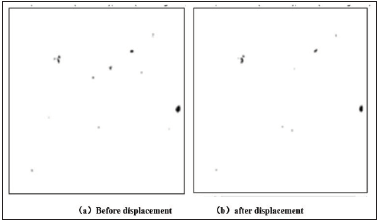
B. Natural core 1-2 was injected with particulate suspensions of particle size 0~1m.
Figure 11:3D image before and after displacement in the middle of core column.

Furthermore, the CT scanning of natural core 1-2 injected with 0 ~ 1μm nanoscale sized ultra-fine calcium carbonate was carried out before and after displacement, and it was found that there were almost no particles left in the core end face. Scanning the middle part of the core, the results are as shown in the Figures 12 & 13. It can be seen that before and after the displacement of the particle suspension, the core slice, the enlarged map of the same position of the core slice and the 3D image of the core pore structure have changed significantly. Compared with before displacement, the proportion of the pore space is reduced by 56.1%, which proves that a large number of particles enter the core pore throat and block the core seriously Figures 12 & 13.
Figure 12:Porosity change at a certain position of slice.
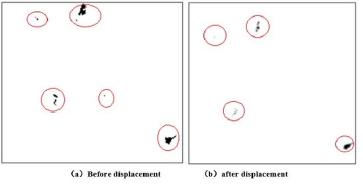
Figure 13:3D image before and after displacement in the middle of core column.
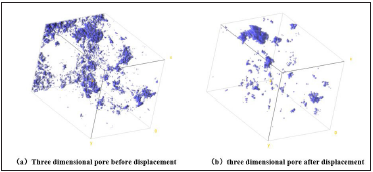
Conclusion
Igneous rock core has poor physical properties, low porosity
and permeability; chlorite is the main clay mineral, which can
reduce the effective pore radius and plug the pore throat; the rock sample is closely cemented and mainly develops micro dissolved
pore fractures with small pore diameter, mostly nano micron pores.
With the increase of velocity, the gas velocity leads to the
migration of inherent particles in the reservoir core, and then the
particles migrating to the throat will intercept the later particles
and cause further plugging. The results of NMR on-line monitoring
show that the particles between the pores are washed away, and
the loose particles migrate to the pores to fill. Therefore, in order to
prevent particle migration in macropores, the velocity of fluid in the
formation must be controlled below the critical velocity.
The results show that different particle size or concentration
of volcanic particle suspension can damage cores with different
permeability, and the maximum damage is 56.1%. When the
particle size is small and the particle weight per liter is low, the
main plugging method is surface precipitation. With the increase
of particle concentration, filling or pore throat plugging is the main
plugging method. The results of CT scanning show that the porosity
of core changes obviously with the plugging of particles.
Acknowledgement
This work was financially supported by the National Natural Science Foundation of China (NO. 51974351; NO. 51704322; Major Program, NO. 51991361) and the National Science and Technology Major Project of China (NO. 2016ZX05040-005).
References
- Minxue J, Luo Liqiong L (2005) Experimental judgment of particle migration in reservoir. Natural Gas Exploration and Development 2: 61-64.
- Ying L, Junyu P, Zhili F (2012) Application of particle migration in reservoir protection. Western Exploration Engineering 24(11): 52-54.
- Xiaoguang Y, Weifeng L, Hong D, Tao W, Baolu Z, et al. (2015) Analysis of Permian volcanic reservoir characteristics and control factors in Kebai area. Fault Block Oil and Gas Field 22(4): 445-449.
- Long L, Binshan J, Huaiyou J (2011) Reservoir particle migration and its influence on reservoir physical properties. Zhongwai energy 12: 56-60.
- Yong G, Wanru H, Ge T, Wei Z, Changmei L, et al. (2010) Study on filling evolution of paleogene igneous reservoir space in coastal area. Fault Block Oil and Gas Field 17(6): 652-654.
- Hao F, Rui C, Chengxin Y (2011) Mechanism and prevention of particle migration in shallow sandstone reservoirs. China Petroleum and Chemical Standards and Quality 9: 196-200.
- Longlong C, Weibo W (2015) Core velocity sensitivity evaluation experiment of low permeability reservoir. Petrochemical Technology 7: 145-146.
- Xiaorong L, Lihua Y, Dajian L (2008) Experimental study on particle migration induced by water injection in Xifeng oilfield. Fault block oil and gas field 15(2): 81-82.
- Yiting X, Chaohui C (2013) Experimental study on permeability sensitivity of unconsolidated sandstone gas reservoir. Fault Block Oil and Gas Field 20(4): 488-491.
- Jian Y (2005) Study on damage mechanism and protection technology of tight sandstone gas reservoir in central Sichuan. Southwest Petroleum Institute, China.
- Qingju L, Chengzu H, Jingping S (2006) Study on macroscopic law of particle migration damage. Oil and Gas Field Surface Engineering 3: 17-18.
- Huiping L, Xianhua C, Liangchuan L, Xiaojuan L (1996) Characteristics of particle migration in unconsolidated sand and its influence on oil well performance. Fault Block Oil and Gas Field 6: 31-34.
- Xianyou Y, Shizhong F, Xin W, Migration degree of common particles in oil and gas reservoirs and their relationship with zeta potential. Oilfield Chemistry, pp. 1-6.
- Xin W, Daming Z, Shizhong F (1991) Study on migration mechanism of particles in reservoir. Drilling and Completion Fluids 8(3): 51-64.
- Lihua Z, Yiqiao Z, Dongyang J (2017) Calculation of permeability of rocks with complex pore structure using nuclear magnetic T2 spectrum data. Foreign Logging Technology 1(4): 12-14.
- T NMR (2009) Was used to study the mechanism of nuclear magnetic resonance (NMR)_2 spectral classification of igneous secondary pore reservoir. Foreign well logging technology 4(5): 21-25.
- T NMR of Sandstone Rocks, Songtao B, Daojie C, Jinbin W (2016) _2 spectral quantitative characterization. Acta petroleum Sinica 37(3): 98-107.
- Hu Aijun (2007) Experimental study on methane migration in coal by nuclear magnetic resonance. Liaoning University of Engineering and Technology, China.
- Yu Z, Guoqi W, Hekun G (2011) Analysis and calibration of nuclear magnetic resonance porosity influencing factors. Logging Technology 35(3): 210-214.
- Jianping Y, Xu H, Bin G, Hu QH, Feng CZ, et al. (2017) Multifractal characteristics of nuclear magnetic resonance T2 spectrum and its application in pore structure evaluation. Applied Geophysics 14: 205-215.
- Yuan Y, Shengping G (2016) NMR experimental study on reservoir porosity sensitivity damage. Science and Technology and Engineering 16(11): 157-161.
- Junchang S, Hekun G, Zhengming Y (2011) Experimental study on core nuclear magnetic resonance porosity of igneous gas reservoirs with different lithology. Journal of Southwest Petroleum University 5(9): 49-56.
© 2021 Weian H. This is an open access article distributed under the terms of the Creative Commons Attribution License , which permits unrestricted use, distribution, and build upon your work non-commercially.
 a Creative Commons Attribution 4.0 International License. Based on a work at www.crimsonpublishers.com.
Best viewed in
a Creative Commons Attribution 4.0 International License. Based on a work at www.crimsonpublishers.com.
Best viewed in 







.jpg)






























 Editorial Board Registrations
Editorial Board Registrations Submit your Article
Submit your Article Refer a Friend
Refer a Friend Advertise With Us
Advertise With Us
.jpg)






.jpg)














.bmp)
.jpg)
.png)
.jpg)










.jpg)






.png)

.png)



.png)






